Branding Archetypes: Building Lasting Connections
We're about to explore an idea at the crossroads of psychology, mythology, and marketing—branding archetypes. Buckle up! Because it's going to be an exciting ride!
As a branding expert, I often find myself in conversations where people ask, “How can we make our brand more relatable? How can we evoke emotions that resonate deeply with our audience?” And my answer, more often than not, harkens back to an ancient concept that's been around since the dawn of human storytelling: archetypes.
Archetypes are universally familiar characters or themes that evoke deep emotional responses, providing a sturdy bridge between your brand and your audience's hearts. From the carefree Jester to the inspirational Hero, these timeless personas infuse your brand story with depth, meaning, and humanity.
But don't just take my word for it. Stick around as we dive deeper into this fascinating concept, unpacking how archetypes can be a game-changer in establishing a brand's identity, imbuing it with authenticity, and ultimately, forging connections that are not just transactional but profoundly emotional and enduringly loyal.
So whether you're a seasoned branding professional or a budding entrepreneur, this exploration into the world of branding archetypes promises to be a treasure trove of insights, inspiration, and innovative strategies. Let's unravel the secret to building lasting connections, one archetype at a time.
Table of Contents
Understanding Branding Archetypes
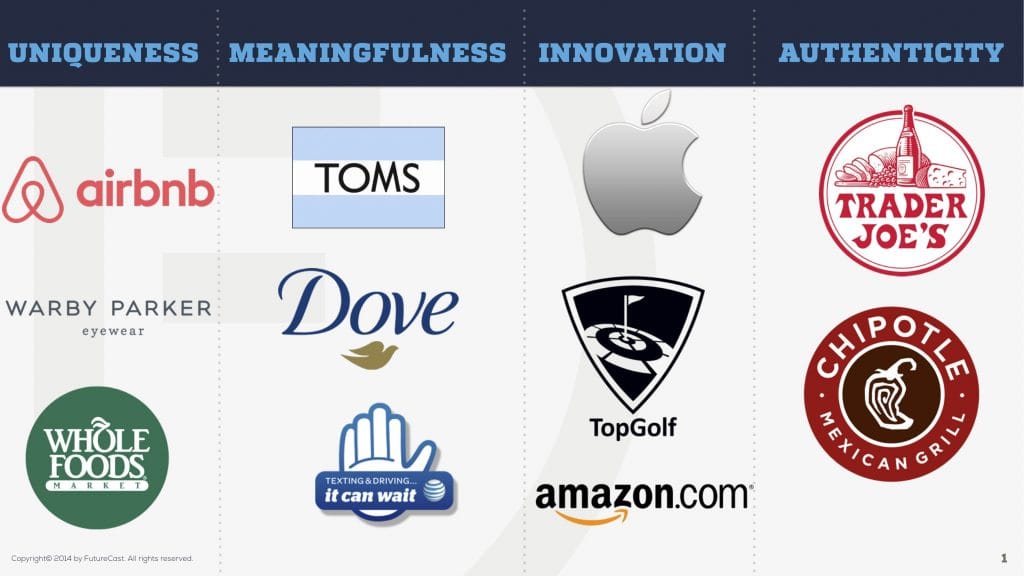
Branding archetypes are like these universal character profiles that go way back and are deeply connected to human psychology and storytelling. They're like these timeless patterns that reflect how we behave, what motivates us, and what we desire. It's fascinating how they capture these fundamental aspects of our nature.
When companies align their brand with a specific archetype, they tap into this powerful force within our collective consciousness. It's almost like magic! By doing so, they can evoke these intense emotional responses from us, influencing the way we see and engage with their brand. It's remarkable how branding can shape our perceptions and interactions.
Think about it. When a brand embodies the archetype of the Hero, for example, it taps into our longing for courage, triumph, and making a difference. It inspires us to overcome obstacles and take on challenges. On the other hand, a brand that embodies the Jester archetype appeals to our desire for joy, spontaneity, and laughter. It adds a sense of fun and lightness to our lives.
And it's not just about these two archetypes. There are many others, each with its unique characteristics and appeal. The Sage archetype, for instance, represents wisdom, knowledge, and enlightenment. Brands that embody this archetype provide insights, guidance, and expertise to help us make informed decisions.
Companies can create powerful connections by understanding these archetypes and strategically aligning their brand with the one that resonates most with their target audience. It's about finding that sweet spot where the brand and the consumer's deepest desires and aspirations come together. When that happens, it's like a spark ignites, and the brand becomes more than just a product or service—it becomes a symbol of identity and fulfilment.
So, the next time you come across a brand that seems to speak directly to your soul, remember it's tapping into one of these timeless archetypes. It's leveraging the power of storytelling and psychology to capture your attention, evoke emotions, and shape your perception. Amazingly, something as intangible as an archetype can profoundly impact our relationship with brands.
The Power of Archetypes in Branding
Archetypes have been utilised in storytelling and mythology for centuries, captivating audiences with relatable characters and narratives. In branding, archetypes are a powerful tool to communicate a brand's values, personality, and purpose. By connecting with consumers emotionally, archetypal branding helps build trust, loyalty, and a sense of identity among target audiences.
Benefits of Implementing Branding Archetypes
Embracing branding archetypes offers several key benefits for businesses:
- Differentiation: Archetypal branding helps companies differentiate themselves from competitors by embodying a distinct and memorable brand identity.
- Emotional Connection: Archetypes tap into consumers' emotions, fostering a deeper connection and resonance with the brand.
- Brand Consistency: Archetypes provide a consistent framework for brand communication, ensuring a cohesive and unified brand experience across various touchpoints.
- Storytelling: Archetypes enable brands to tell compelling stories that engage and captivate audiences, creating a narrative beyond product features.
Exploring Branding Archetypes
1 – The Innocent: A Journey of Pure Delight

Imagine walking through a sun-kissed meadow, embracing the gentle breeze on your face, and feeling the warmth of happiness. That's the essence of The Innocent archetype. It embodies a spirit of naivety, trust, and unwavering optimism. Brands representing The Innocent archetype connect with their audience by offering a safe and comforting haven, evoking joy, nostalgia, and a yearning for simpler times.
Characteristics of The Innocent:
- Simplicity: The Innocent archetype thrives on the beauty of simplicity. Brands that embrace this archetype present themselves with a straightforward, uncluttered approach, making their message clear and easily understandable.
- Authenticity: These brands are honest, transparent, and genuine in their actions. They foster trust and build relationships by delivering on their promises, consistently embodying their core values.
- Optimism: The Innocent archetype radiates positivity, seeing the world through rose-tinted glasses. Brands in this archetype focus on uplifting narratives, highlighting the bright side of life and reminding us of the goodness surrounding us.
- Nostalgia: By tapping into memories of childhood or simpler times, brands evoke a sense of nostalgia. They transport us to a place of innocence, reminding us of the carefree joys we experienced in our past.
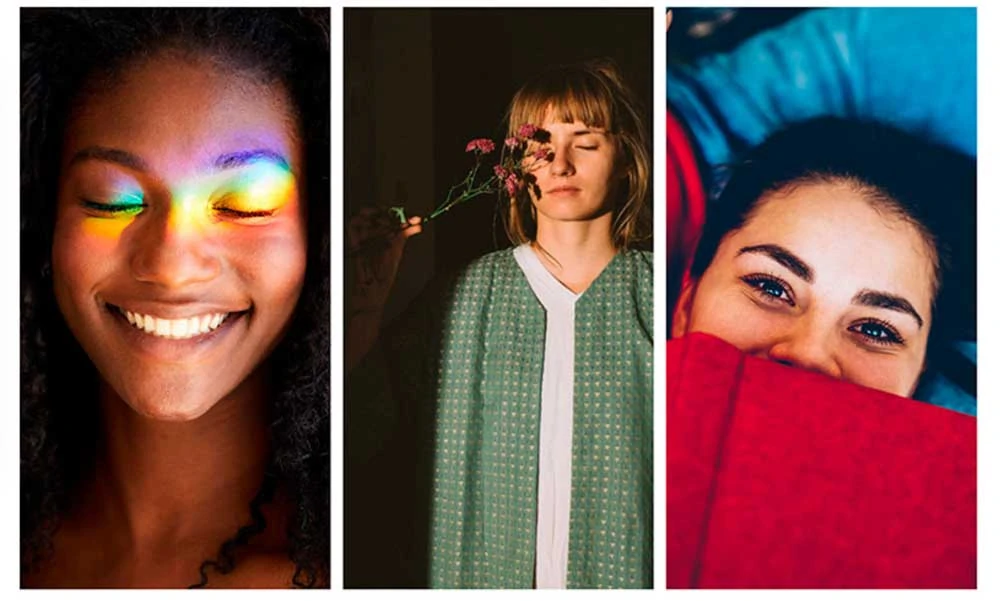
Real-World Examples of The Innocent Archetype:
- The Walt Disney Company: A true embodiment of The Innocent, Disney transports us to a world where dreams come true. With its iconic characters, magical storytelling, and enchanting theme parks, Disney captures the essence of innocence and wonder, captivating audiences of all ages.
- Coca-Cola: For over a century, Coca-Cola has celebrated the simple joys of life, spreading happiness and unity through its iconic red and white branding. The brand's classic advertisements featuring joyful people and catchy jingles evoke feelings of nostalgia and the pleasures of shared moments.
- Innocent Drinks: As the name suggests, Innocent Drinks embraces The Innocent archetype wholeheartedly. Known for its natural and healthy beverages, Innocent Drinks uses playful and vibrant branding and commitment to sustainability to create a sense of trust and simplicity.
- LEGO: LEGO's colourful building blocks bring out the childlike imagination in all of us. By encouraging creativity, fostering playfulness, and embracing the purity of childhood, LEGO embodies The Innocent archetype, promoting endless possibilities and fun.
- Toms: Toms, a shoe and eyewear company, embodies The Innocent archetype through its “One for One” business model. For every product purchased, Toms donates a pair of shoes or eyewear to someone in need. By aligning their brand with philanthropy and making a positive impact, Toms evokes feelings of trust and goodness.
The Innocent archetype serves as a refreshing oasis in a world often filled with complexity and cynicism. Brands that embrace this archetype transport us to a place where simplicity, trust, and joy reign supreme. Through genuine and optimistic narratives, they connect with audiences deeply emotionally, reminding us of the beauty of life's little moments.
2 – The Hero Archetype: A Force of Inspiration
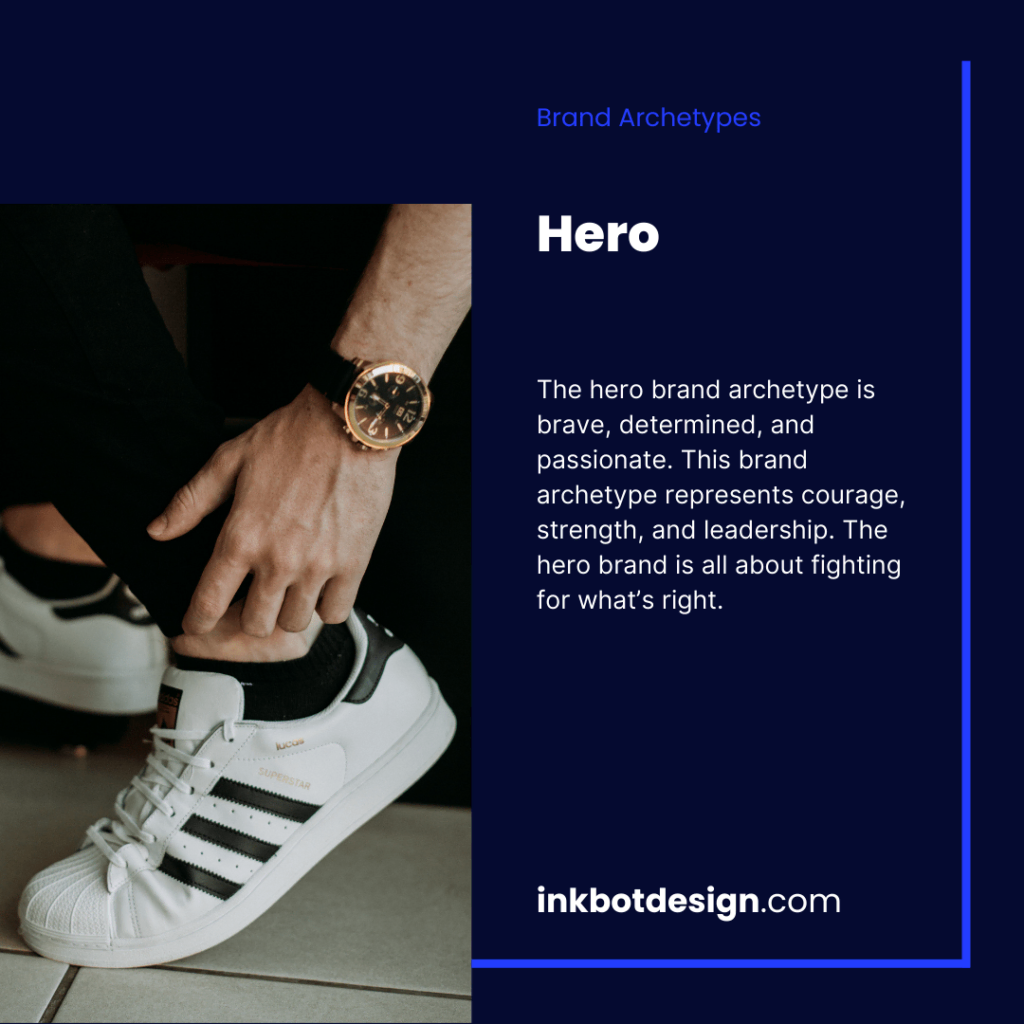
The Hero archetype taps into our deep-rooted desire for triumph, courage, and personal growth. It resonates with our innate yearning to overcome challenges, push boundaries, and create positive change. Brands that embody the Hero archetype position themselves as catalysts, empowering customers to embark on their heroic journeys.
Characteristics of the Hero Archetype:
- Courage and Determination: Heroes are known for their bravery and unwavering resolve in adversity. They inspire us to face challenges head-on, conquer our fears, and achieve greatness. Brands that align with the Hero archetype exude these qualities, motivating customers to overcome obstacles and push their limits.
- Champion of Change: Heroes are catalysts for positive transformation, leading toward a better future. Brands that embrace the Hero archetype position themselves as agents of change, actively addressing societal issues and positively impacting the world. They encourage customers to join the cause and be part of something greater.
- Inspiring Stories: Heroes captivate us with their compelling narratives of triumph, showcasing their journey from humble beginnings to extraordinary achievements. Brands that embody the Hero archetype craft captivating stories that resonate with their audience's aspirations and dreams. These brands inspire and motivate their customers by showcasing real-life heroes and highlighting their journeys.
- Symbolic Imagery: The Hero archetype often employs visual symbolism associated with bravery, strength, and victory. Bold colours, strong typography, and iconic imagery evoke a sense of empowerment and ignite the heroic spirit within customers. These visual cues become a recognisable element of the brand's identity, reinforcing its association with the Hero archetype.
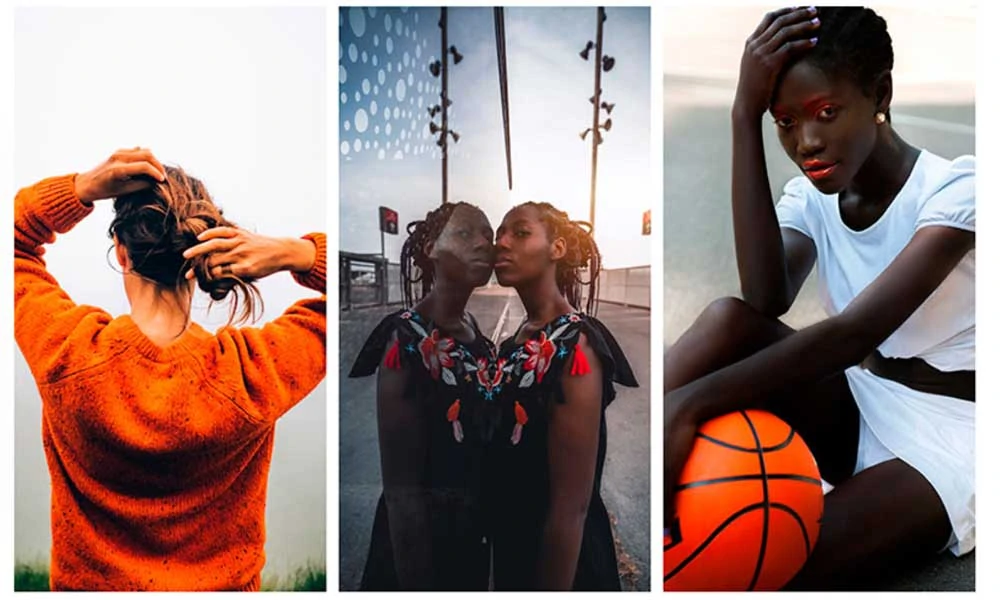
Real-World Examples:
- Nike: Just Do It” Nike, one of the world's most renowned sportswear brands, embraces the Hero archetype with its iconic slogan, “Just Do It.” Nike's marketing campaigns feature athletes overcoming challenges and pushing their limits, inspiring customers to pursue their goals fearlessly. By celebrating the heroic spirit within individuals, Nike has built a brand that embodies courage, determination, and the relentless pursuit of excellence.
- Tesla: Accelerating Sustainable Change Tesla, the electric vehicle pioneer, positions itself as a Hero by championing sustainable transportation and striving to accelerate the transition to clean energy. By presenting CEO Elon Musk as a visionary hero leading the charge against climate change, Tesla inspires customers to be part of the movement towards a greener future. Tesla's sleek design, cutting-edge technology, and disruptive innovation reinforce its Hero archetype, symbolising progress and the power to make a difference.
- Red Bull: Wings for the Fearless Red Bull, the energy drink brand, embodies the Hero archetype by emphasising the spirit of adventure and pushing boundaries. Through extreme sports events and sponsorships, Red Bull celebrates individuals who dare to take risks, conquer challenges, and redefine limits. By associating its brand with thrilling feats of bravery, Red Bull taps into the hero within its customers, encouraging them to pursue their passions and live life to the fullest.
The Hero archetype is a captivating branding strategy that taps into our collective desire for empowerment, courage, and personal growth. Brands that embrace this archetype inspire and motivate customers by championing change, telling compelling stories, and embodying the qualities of bravery and determination. By aligning themselves with the Hero archetype, brands create an emotional connection with their audience, fostering loyalty and empowering customers to embark on their heroic journeys. So, go forth and unleash the hero within you!
3 – The Everyman: Relatable Brands for Everyday Heroes

The Everyman archetype represents the ordinary person, the hero-next-door who faces life's everyday challenges with determination and resilience. It embraces the idea that regular individuals have extraordinary stories and that their experiences and emotions matter. Brands embody the Everyman archetype and aim to personally connect with their audience, acknowledging their struggles, aspirations, and desires.
Characteristics of the Everyman Archetype:
- Authenticity: Brands embodying the Everyman archetype are genuine and transparent, avoiding pretence or exaggerated claims. They aim to establish trust and reliability with their audience by being relatable and honest.
- Simplicity: The Everyman archetype rejects complexity and focuses on simplicity. Brands following this archetype adopt straightforward messaging and design that are easy to understand and resonate with the everyday person.
- Empathy: Understanding the struggles and triumphs of their audience is vital for Everyman brands. They showcase compassion by acknowledging and addressing the challenges faced by everyday individuals, making their customers feel seen, heard, and understood.
- Humility: Everyman brands don't flaunt their accomplishments or put themselves on a pedestal. Instead, they humbly celebrate their customers' achievements and spotlight their stories.
- Margaret Hartwell (Author)
- English (Publication Language)
- 158 Pages – 09/13/2012 (Publication Date) – HOW Books (Publisher)
Real-World Examples:
- IKEA: IKEA is an excellent example of an Everyman brand. They focus on providing affordable, functional, and stylish furniture and home decor, catering to the needs of the everyday person. Their marketing campaigns often showcase relatable situations where people struggle with small living spaces or budget constraints. IKEA celebrates the victories of their customers by empowering them to create beautiful homes, regardless of their background or income level.
- Coca-Cola: Coca-Cola, the world-renowned beverage brand, embraces the Everyman archetype by promoting universal values such as happiness, togetherness, and sharing. Their advertisements often depict people from diverse backgrounds enjoying moments of connection over a bottle of Coca-Cola. Coca-Cola establishes an emotional bond with their audience by emphasising the joy and unity in everyday interactions.
- Subaru: Subaru has successfully embraced the Everyman archetype by positioning itself as the car brand for adventure-seeking individuals who prioritise safety and reliability. Their advertising campaigns often feature Subaru owners' real stories and everyday journeys. Subaru connects with its audience by understanding their need for practicality, reliability, and a sense of adventure, fostering a loyal community of Subaru owners.
- Levi's: Levi's, the iconic denim brand, embodies the Everyman archetype by celebrating the uniqueness and individuality of its customers. They understand everyone has a story to tell, and their jeans witness their adventures. Levi's advertisements often depict diverse individuals expressing their style, emphasising the universality of jeans as a staple in people's lives.
The Everyman archetype represents relatability, authenticity, and empathy—traits that resonate with the ordinary person. Brands that successfully embrace this archetype connect with their audience on a deeper level, celebrating their stories and aspirations. Whether it's furnishing homes, sharing moments of happiness, enabling adventure, or embracing personal style, Everyman brands understand the power of everyday experiences and make their customers feel like heroes in their own right. So, keep an eye out for the brands that embrace the Everyman archetype and join the celebration of ordinary heroes all around us!
4 – The Sage: Unveiling the Power of Wisdom
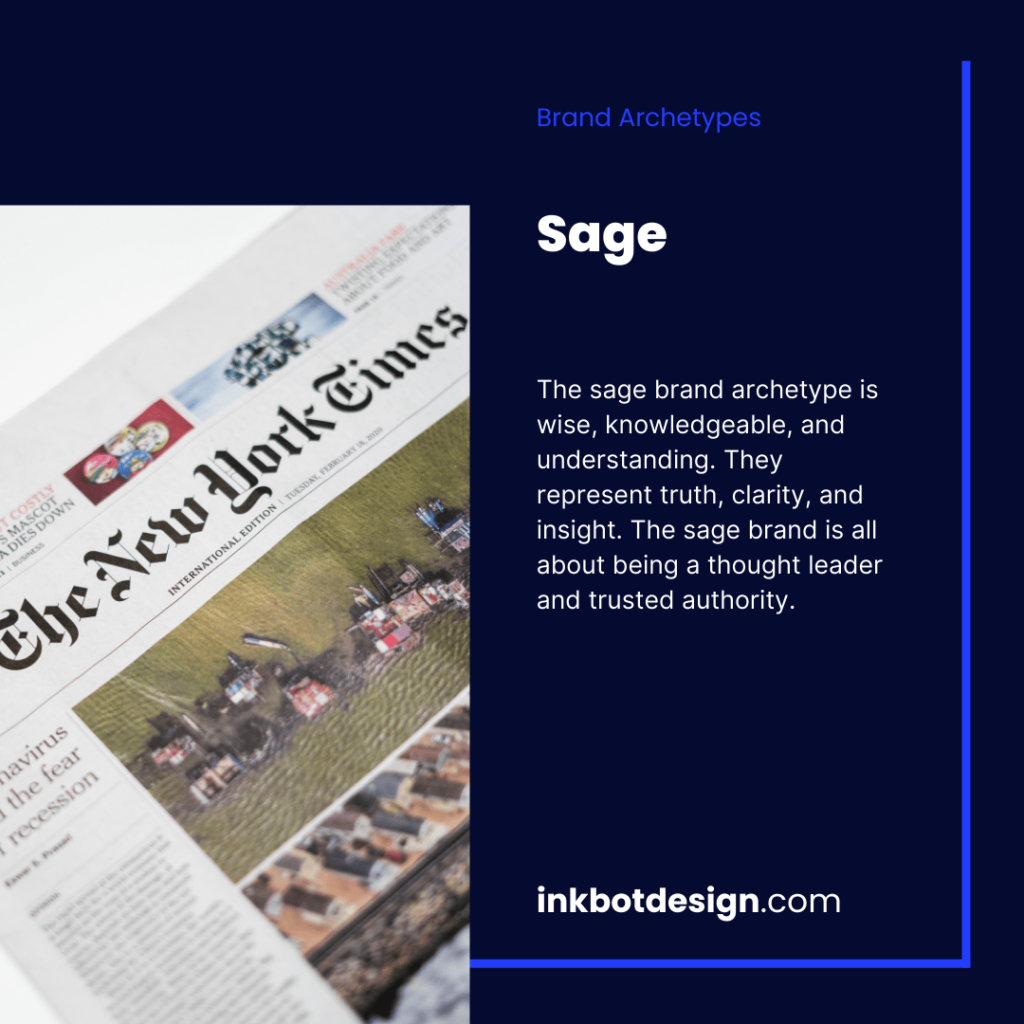
The Sage archetype is rooted in seeking knowledge, wisdom, and understanding. It represents brands driven by a deep desire to educate, guide, and empower their audience. Sages exude an air of authority, expertise, and credibility, making them a trusted source of information and advice.
Characteristics of The Sage:
- Wisdom and Knowledge: Sages possess a vast reservoir of knowledge and are dedicated to sharing it. They aim to enlighten and educate their audience, empowering them with valuable insights.
- Authority and Credibility: Sages are perceived as experts in their field. Their unwavering commitment to accuracy and thorough research establishes trust and credibility among their audience.
- Thought Leadership: Sages are trailblazers in their industry. They have a unique perspective and the ability to anticipate trends, guiding their audience towards innovative solutions.
- Objectivity: Sages prioritise rationality and objectivity. They value critical thinking and strive to provide well-informed, unbiased information.
- Mentorship and Guidance: Sages take on the role of mentors, offering guidance and support to their audience. They are dedicated to helping others make informed decisions and navigate complex situations.
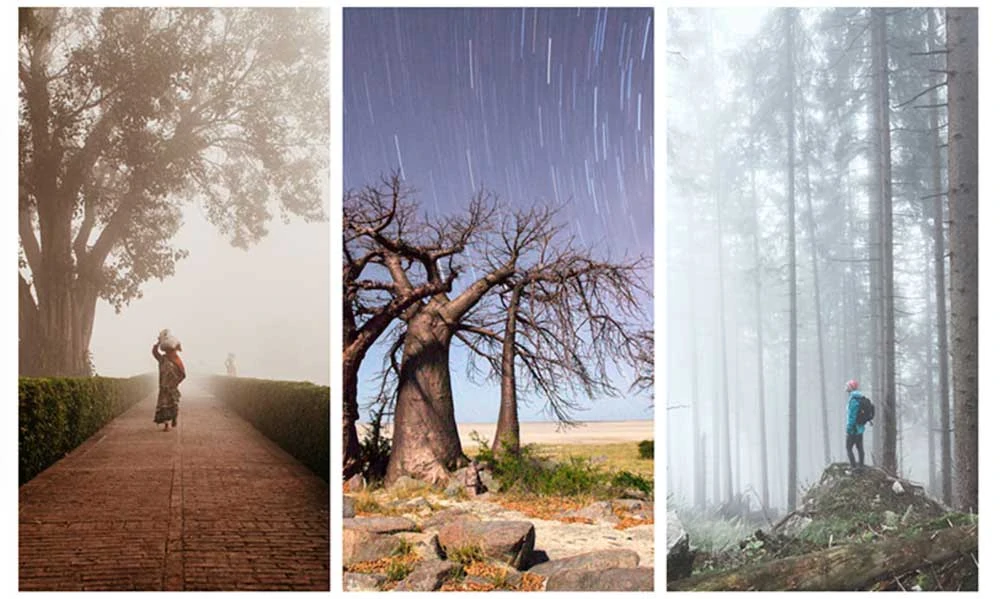
Real-World Examples of The Sage:
- National Geographic: As a global leader in exploration, National Geographic embodies The Sage archetype. It has captivated audiences for years by providing in-depth knowledge about the natural world, scientific discoveries, and cultural insights. National Geographic's commitment to education and enlightenment makes it a trusted source for millions of curious minds.
- TED Talks: TED Talks are renowned for showcasing brilliant individuals who share their expertise and ideas on various subjects. By providing a platform for knowledge-sharing, TED Talks personify The Sage archetype. The talks inspire, inform, and challenge conventional thinking, making them a powerful source of intellectual enlightenment.
- Harvard Business Review: The Harvard Business Review is a revered publication that caters to professionals seeking insights into the business world. With its rigorous research and expert analysis, it epitomises The Sage archetype. The journal provides knowledge, allowing business leaders to make informed decisions and stay ahead of the curve.
- Mayo Clinic: The Mayo Clinic is globally recognised for its expertise in healthcare. It embraces The Sage archetype by offering its audience reliable medical information, research findings, and expert advice. Mayo Clinic's commitment to educating and empowering individuals to make informed health choices positions it as a trusted authority in the industry.
- The New York Times: As one of the most reputable newspapers globally, The New York Times embodies The Sage archetype. Its objective journalism, extensive reporting, and in-depth analysis serve as a beacon of truth and knowledge. The publication aims to inform, enlighten, and foster critical thinking among its readers.
The Sage archetype represents brands that embrace the power of wisdom, knowledge, and guidance. These brands are committed to enlightening their audience, offering valuable insights, and empowering individuals to make informed decisions. By embodying The Sage archetype, brands can establish credibility, trust, and authority, becoming an invaluable resource in their respective industries.
5 – The Explorer Archetype: Unleashing the Spirit of Discovery
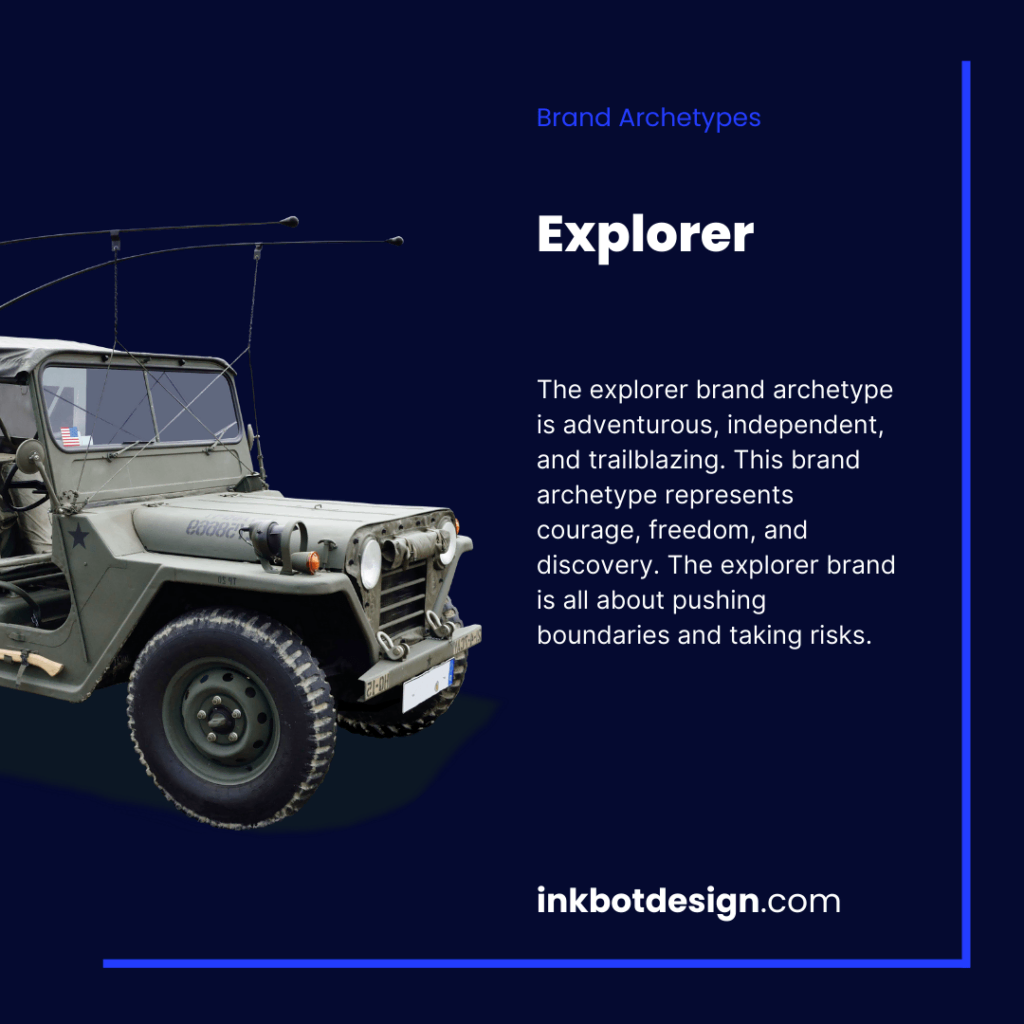
The Explorer archetype symbolises the yearning for new experiences, the thrill of the unknown, and the courage to venture beyond comfort zones. These brands possess an insatiable curiosity and a deep-rooted desire to explore uncharted territories. They inspire us to break free from constraints, challenge conventions, and embark on quests of self-discovery.
Characteristics of the Explorer Archetype:
- Adventurous Spirit: Brands that embody the Explorer archetype represent a sense of adventure, curiosity, and a willingness to embrace the unknown. They inspire us to seek new experiences and escape the mundane.
- Freedom and Independence: These brands celebrate individuality, space, and self-reliance. They encourage us to forge our paths unencumbered by societal norms and expectations.
- Discovering New Frontiers: Explorers thrive on finding new possibilities and uncharted territories. Brands in this archetype continuously push boundaries, innovate, and explore unexplored realms to stay ahead of the game.
- Authenticity: Brands aligned with the Explorer archetype radiate authenticity and a genuine desire to explore and learn. They establish a strong emotional connection by demonstrating sincerity and transparency.
- Unconventional Thinking: The Explorer archetype encourages thinking outside the box, challenging the status quo, and embracing unconventional approaches. These brands inspire us to question assumptions and strive for breakthrough ideas.
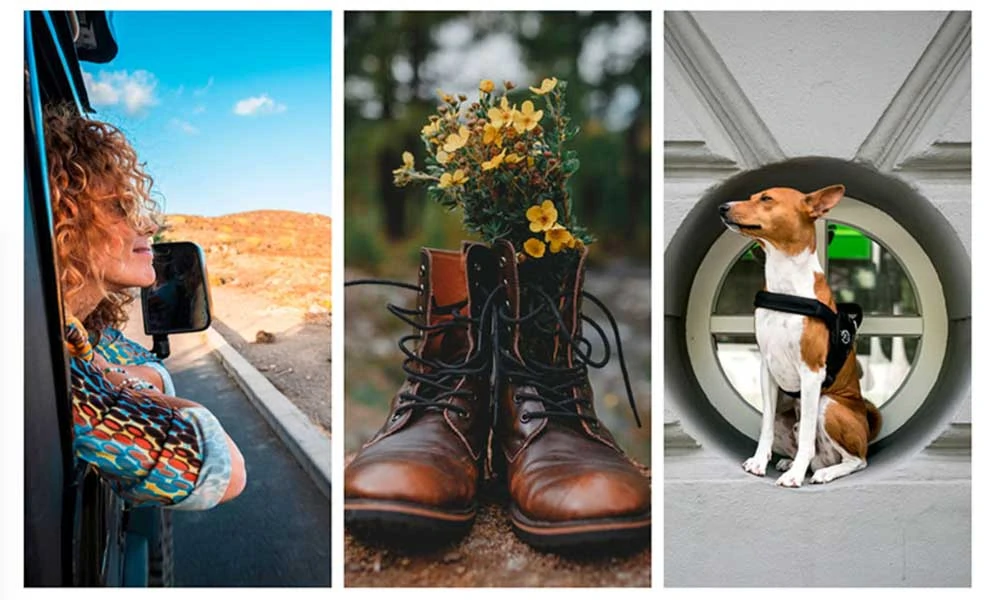
Real-World Examples of Explorer Archetype Brands:
- The North Face: As a renowned outdoor apparel brand, The North Face embodies the spirit of exploration and adventure. Their marketing campaigns feature breathtaking landscapes and stories of real-life explorers who have conquered formidable challenges, inspiring us to embrace the great outdoors and push our boundaries.
- GoPro: GoPro, the action camera brand, empowers individuals to capture and share their adventures. By positioning itself as the ultimate tool for capturing thrilling moments, GoPro encourages people to embark on daring expeditions and document their journeys, fostering a community of fearless explorers.
- National Geographic: A true pioneer in exploration and storytelling, National Geographic brings the world's wonders to our doorstep. Captivating visuals and narratives ignite our curiosity, transporting us to remote locations and promoting a deeper understanding of the world.
- Patagonia: Patagonia, the outdoor clothing company, epitomises the Explorer archetype by encouraging sustainable exploration. They inspire consumers to embrace nature, champion environmental causes, and equip themselves with durable products for their adventures.
- Tesla: The electric vehicle manufacturer Tesla embodies the Explorer archetype by challenging conventional norms in the automotive industry. With a focus on sustainability and cutting-edge technology, Tesla pushes boundaries, encouraging us to explore a future where clean energy and innovation coexist.
Brands aligned with the Explorer personality captivate our hearts and minds by embarking on daring quests and embracing the thrill of discovery. They inspire us to push boundaries, seek new horizons, and embark on adventures. Through authenticity, a spirit of experience, and a desire to explore uncharted territories, these brands leave an indelible mark on our lives.
6 – The Lover Archetype: Igniting Passion in Branding
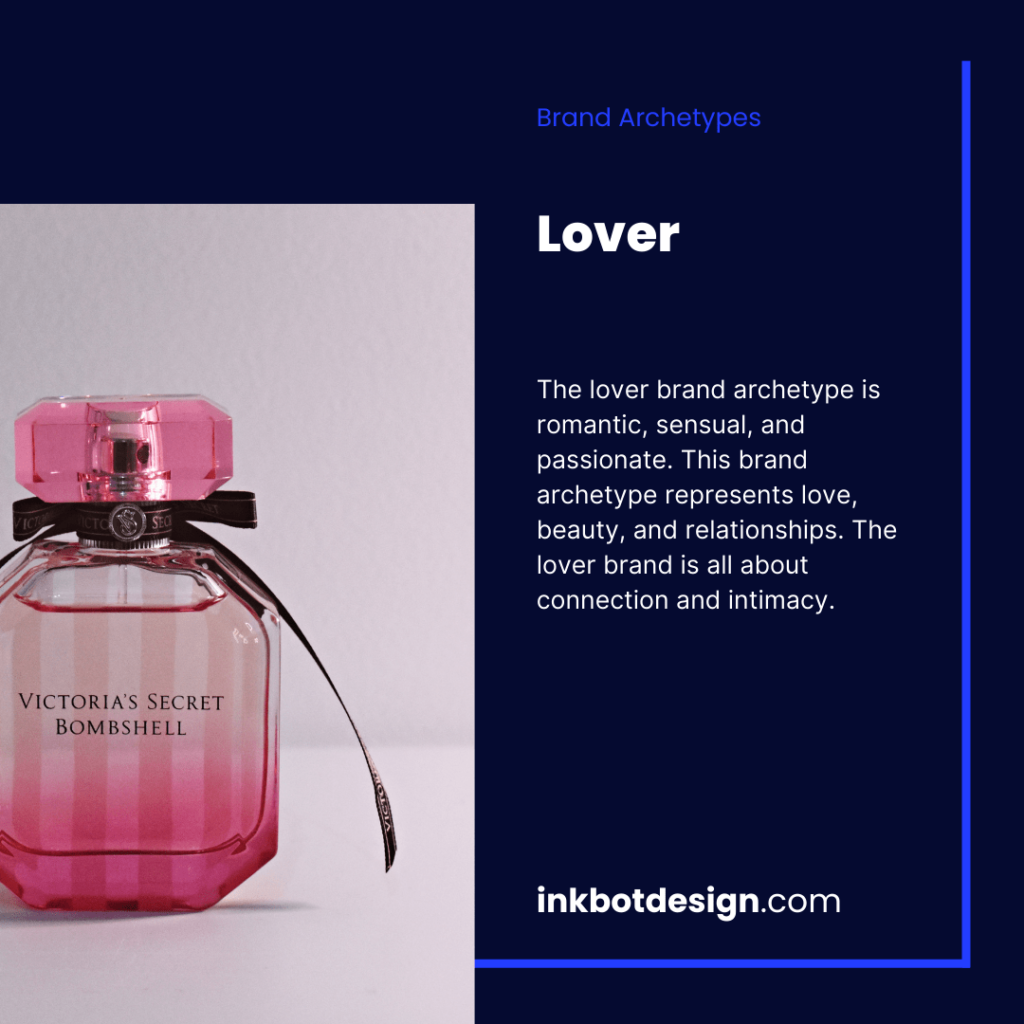
At the core of the Lover archetype lies a profound longing for beauty, pleasure, and love. Brands embody the Lover archetype seek to evoke intense emotions and create sensory experiences that enthral their target audience. This archetype taps into the deepest desires of individuals, arousing feelings of passion, sensuality, and emotional connection. By intertwining their brand story with themes of romance and desire, these brands strive to establish lasting relationships with their customers.
Characteristics of the Lover Archetype:
- Passion and Emotion: The Lover archetype exudes passion and emotion, infusing brands with an air of intensity and excitement. Such brands celebrate the pleasure of indulgence and embrace the power of human connection, allowing consumers to experience a deep emotional bond with their products or services.
- Sensuality and Beauty: Brands that embody the Lover archetype prioritise aesthetic appeal and sensuality. They craft experiences that stimulate the senses, incorporating captivating visuals, enchanting scents, musical sounds, and luxurious textures to create an immersive and pleasurable encounter.
- Authenticity and Intimacy: The Lover archetype thrives on genuine connections and intimacy. Brands that align with this archetype strive to build authentic customer relationships, demonstrating empathy, understanding, and a commitment to fulfilling their desires and needs.
- Romance and Storytelling: Storytelling plays a crucial role in the Lover archetype. Brands harness the power of narratives to evoke emotions, create fantasies, and engage the audience in a romantic journey. They weave tales of love, passion, and desire, capturing the hearts of consumers and forging lasting brand loyalty.
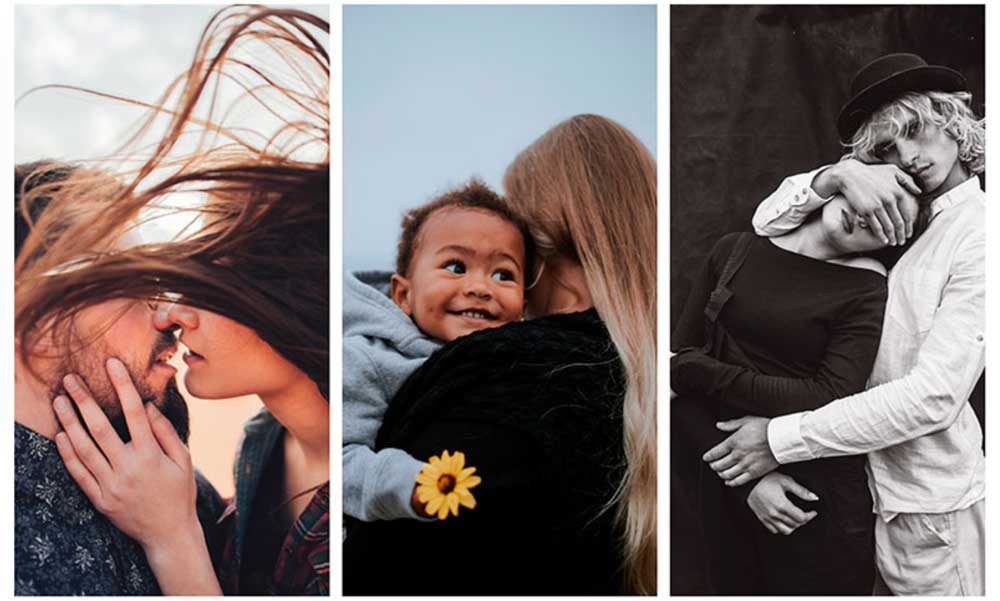
Real-World Examples of the Lover Archetype:
- Chanel: The iconic French fashion and fragrance house, Chanel, epitomises the Lover archetype. With its timeless elegance, sensual fragrances, and luxurious designs, Chanel evokes feelings of desire, sophistication, and allure. The brand has masterfully crafted a narrative around the spirit of Coco Chanel, a woman who embodied passion, independence, and a love for beauty.
- Godiva: As a renowned chocolatier, Godiva personifies the Lover archetype through its exquisite chocolates and immersive experiences. The brand celebrates the pleasure of indulgence, captivating consumers with premium products, beautiful packaging, and enchanting store environments. Godiva kindles the romance of chocolate, creating an emotional connection beyond mere taste.
- Victoria's Secret: A globally recognised lingerie brand, Victoria's Secret taps into the Lover archetype by embracing sensuality, beauty, and femininity. Through glamorous fashion shows, captivating visuals, and empowering messaging, Victoria's Secret creates a fantasy world, making women feel confident, desired, and alluring.
- Hallmark: Hallmark, the greeting card and gift company, embodies the Lover archetype by celebrating emotions and human connections. The brand crafts sentimental and heartfelt messages to create love, celebration, and appreciation moments. Hallmark's commitment to fostering meaningful relationships has made it a trusted companion in expressing heartfelt sentiments.
The Lover archetype possesses a magnetic allure that captivates consumers, touching their hearts and kindling desires. Brands that embrace this persona craft experiences that evoke intense emotions, sensuality, and a yearning for connection. Through storytelling, authenticity, and a focus on beauty, these brands forge lasting relationships with their audience. As branding experts, understanding and harnessing the power of the Lover archetype can unlock the potential for creating enchanting brand experiences that resonate deeply with consumers, fostering loyalty and love that stands the test of time.
7 – The Creator: Empowering Imagination

“The Creator” archetype is a powerful force that resonates with individuals who possess a deep passion for originality and the power to bring ideas to life. This archetype thrives on the core desire to transform visions into tangible realities. It fuels the imagination and encourages thinking beyond conventional boundaries, inspiring others to embrace their creativity.
Brands embodying “The Creator” archetype have distinct qualities that set them apart. They are often associated with:
- Innovation: These brands are at the forefront of cutting-edge ideas, continuously seeking to challenge the status quo. They excel in creating revolutionary products or services that reshape industries and change how we perceive the world.
- Imagination: “The Creator” archetype brands celebrate the power of imagination, encouraging individuals to explore their creative potential. They create narratives that captivate and inspire, enabling customers to envision a world where possibilities are endless.
- Authenticity: Brands embodying this archetype strive to maintain authenticity in their endeavours. They value transparency, originality, and honesty, allowing them to build strong relationships with their customers based on trust.
- Experimentation: Constant experimentation is a hallmark of “The Creator” archetype. These brands embrace calculated risks, exploring uncharted territories and pushing the boundaries of what's possible. They understand that innovation often requires stepping into the unknown.

Real-World Examples:
- Apple: the tech giant is a perfect example of “The Creator” archetype. From the visionary mind of Steve Jobs to the company's commitment to groundbreaking design and user experience, Apple has transformed the way we interact with technology. They consistently deliver innovative products that resonate with our desires and needs, captivating us with their imaginative approach to technology.
- LEGO: LEGO, the iconic Danish toy company, embodies the spirit of “The Creator” archetype. LEGO empowers children and adults alike to unleash their creativity, constructing imaginative worlds brick by brick. By encouraging open-ended play and limitless possibilities, LEGO nurtures the inventive spirit in individuals, allowing them to create their narratives and inventions.
- Red Bull: the energy drink brand Red Bull embodies “The Creator” archetype through its sponsorship of extreme sports and adventurous endeavours. Red Bull thrives on pushing the boundaries of what is physically possible, inspiring people to live life to the fullest. Through their marketing campaigns and events, they celebrate individuals who dare to defy limits and pursue their passions.
“The Creator” archetype, focusing on innovation, imagination, and authenticity, can captivate and inspire. Brands embodying this archetype infuse the world with ingenious products, immersive experiences, and narratives that challenge the norm. By tapping into the human desire to create, these brands empower individuals and communities to explore their potential, embracing a future where possibilities are limitless. So, unleash your inner creator because the world needs your imaginative spirit!
8 – The Jester: Bringing Joy and Playfulness
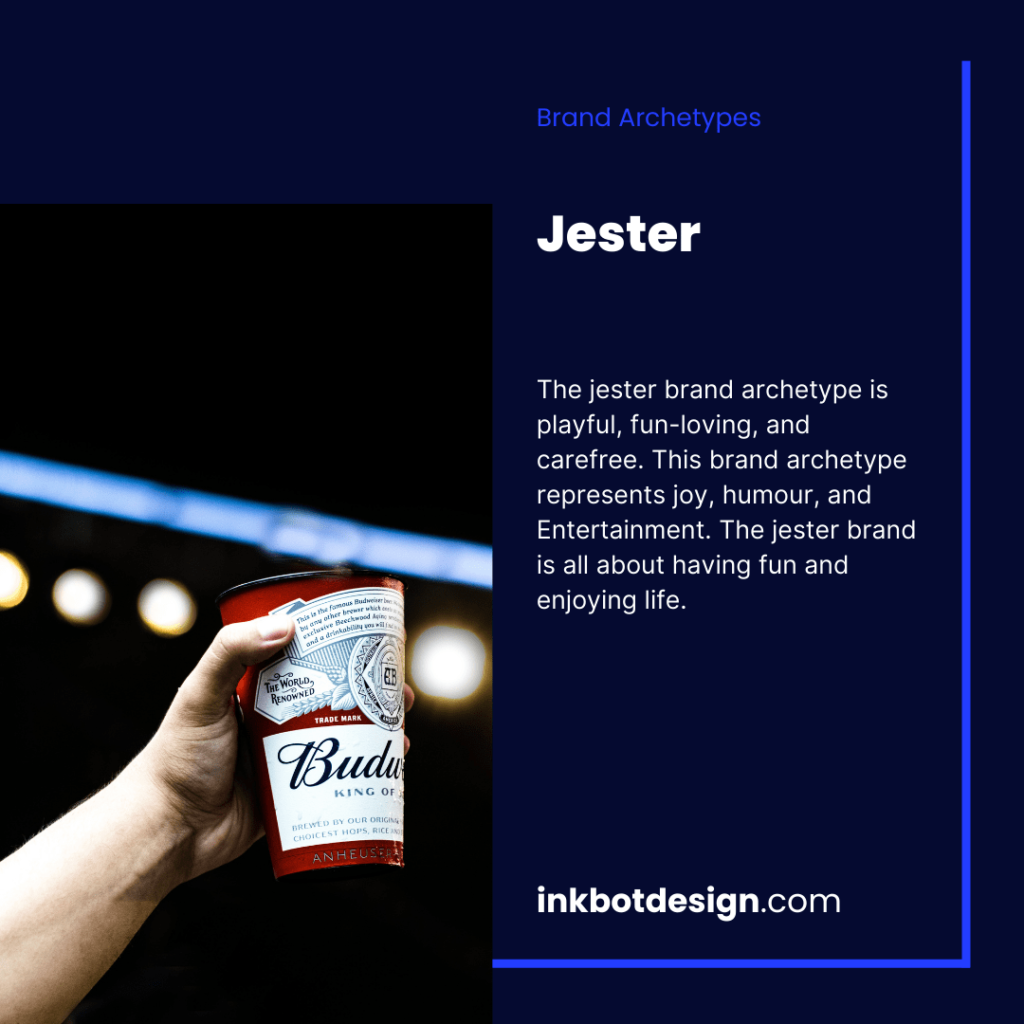
The Jester archetype embodies spontaneity, humour, and a zest for life in branding. These brands thrive on creating moments of joy, surprising their audience, and challenging the status quo. The Jester archetype injects a sense of playfulness into the brand's identity, messaging, and overall experience, leaving a lasting impression on its customers. Brands that adopt this archetype often seek to break away from conventions, inspire laughter, and create memorable interactions.
Characteristics of the Jester Archetype:
- Wit and Humour: Jester brands are masters of humour, employing clever wordplay, puns, and comedic timing to captivate their audience. Their witty approach to storytelling and communication helps them stand out in a crowded marketplace.
- Unpredictability: Jesters thrive on surprise and novelty. They embrace the unexpected, delighting their customers with twists and turns, keeping them engaged and eager for more.
- Playful Creativity: Jester brands are known for their imaginative and out-of-the-box thinking. They employ creative strategies, visuals, and experiences that break the mould and inspire a sense of childlike wonder.
- Challenging the Norm: Jesters are fearless in challenging the status quo. They playfully question conventional wisdom, push boundaries, and encourage their audience to embrace a more light-hearted, carefree approach to life.
- Authenticity: While Jester brands may adopt a playful persona, they still maintain a genuine and authentic connection with their audience. Behind the humour and wit, a sense of relatability resonates with people on a deeper level.

Real-World Examples of Jester Brands:
- Ben & Jerry's: The beloved ice cream brand Ben & Jerry's is a perfect example of the Jester archetype. They create mouthwatering flavours and infuse their brand with social activism and humour. Their playful flavour names, witty social media posts, and unconventional marketing campaigns make them a fan favourite, bringing joy and laughter to their audience.
- Old Spice: Known for its humorous and often absurd commercials, Old Spice embraces the Jester archetype. Their ads featuring over-the-top scenarios and quirky characters have gained widespread attention and redefined the brand's image, making it a standout in the personal care industry.
- Dollar Shave Club: This online subscription-based grooming brand disrupted the market with its humorous and irreverent approach. Through their comedic advertisements and witty copywriting, Dollar Shave Club captured the attention and built a loyal customer base by injecting humour into an otherwise mundane industry.
- MailChimp: As an email marketing service, MailChimp embraces the Jester archetype by infusing playfulness into its brand. Their quirky mascot, Freddie the Chimp, and creative marketing campaigns demonstrate their commitment to bringing joy and humour to their users' inbox experiences.
The Jester archetype in branding is about infusing joy, humour, and playfulness into the customer experience. Brands that adopt this archetype successfully connect with their audience on an emotional level, creating memorable moments and forging lasting relationships. By challenging conventions, embracing creativity, and injecting wit and humour into their messaging, Jester brands to capture attention, inspire laughter, and bring fresh air to the world of branding. So, let the Jester's spirit guide you as you embark on your branding journey, and remember to always keep a smile on your face!
9 – The Caregiver Archetype: Brands That Nourish and Nurture
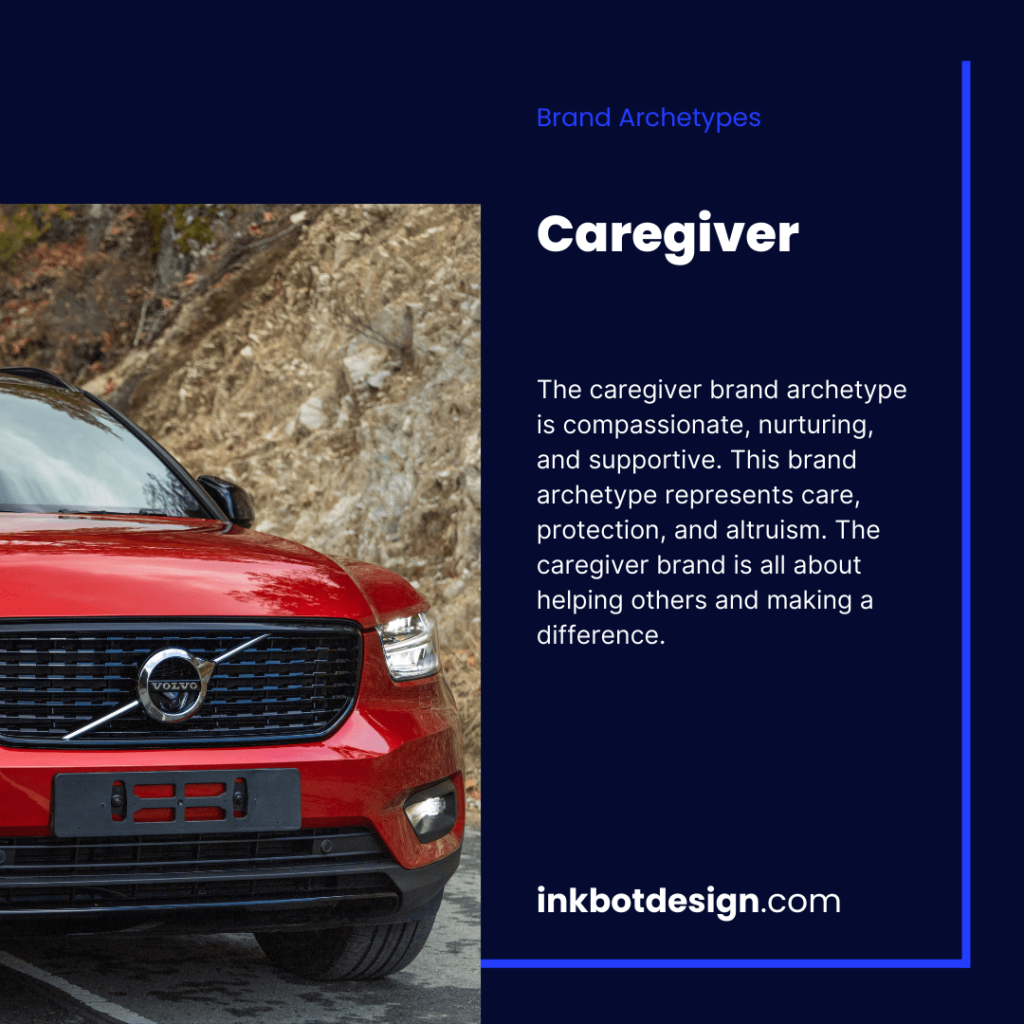
When you think of a caregiver, what comes to mind? Perhaps a loving parent, a selfless nurse, or a trusted friend who always has your back. The Caregiver archetype taps into these nurturing qualities, providing comfort, support, and protection. Brands that embrace this archetype position themselves as caretakers, prioritising the well-being of their customers above all else.
Key Characteristics:
- Compassion and empathy: The Caregiver archetype deeply understands its customers' needs, desires, and pain points. It approaches them with kindness, heart, and a genuine desire to help.
- Nurturing and support: These brands provide safety, reassurance, and guidance. They create an environment where customers feel cared for, supported, and nurtured throughout their journey.
- Trustworthiness and reliability: The Caregiver archetype builds trust by consistently delivering on promises and going the extra mile to protect and assist customers.
- Altruism and social responsibility: Brands embodying The Caregiver archetype often have a solid commitment to positively impacting society. They prioritise giving back, supporting causes, and being socially responsible.

Real-World Examples:
- Johnson & Johnson: This healthcare company has been a prime example of The Caregiver archetype for decades. With products ranging from baby care to medical supplies, Johnson & Johnson consistently demonstrates its commitment to the well-being of families worldwide. Their emphasis on safety, reliability, and nurturing qualities has made them a trusted household name.
- Toms: This shoe brand has carved a niche by embracing The Caregiver archetype through its “One for One” program. Tom's donates a pair to a needy child for every pair of shoes purchased. By addressing the fundamental need for footwear and tying it to a more significant social cause, Toms showcases compassion, empathy, and the desire to make a positive impact.
- Dove: Dove's Real Beauty campaign is a powerful embodiment of The Caregiver archetype. Through thought-provoking advertisements and initiatives, Dove encourages women to embrace natural beauty and feel confident in their skin. By fostering self-esteem and challenging societal beauty standards, Dove takes on the role of a caring advocate for women's well-being.
- Airbnb: This platform has redefined the hospitality industry by creating a community prioritising trust and human connection. By facilitating unique travel experiences and offering support every step of the way, Airbnb embodies The Caregiver archetype. They strive to create a sense of belonging and comfort for travellers, ensuring their well-being during their stay.
The Caregiver archetype holds immense power in a world where consumers seek authentic connections and genuine care. Brands that embrace this archetype can establish strong emotional bonds with their customers by demonstrating empathy, reliability, and a commitment to making a positive impact. By understanding the needs and desires of their audience, these brands create a nurturing environment that fosters trust and loyalty. So, if you're building a brand, consider adopting The Caregiver archetype and watch your brand flourish as you nourish and nurture those who engage with it.
10 – The Ruler: Commanding Brands That Reign Supreme
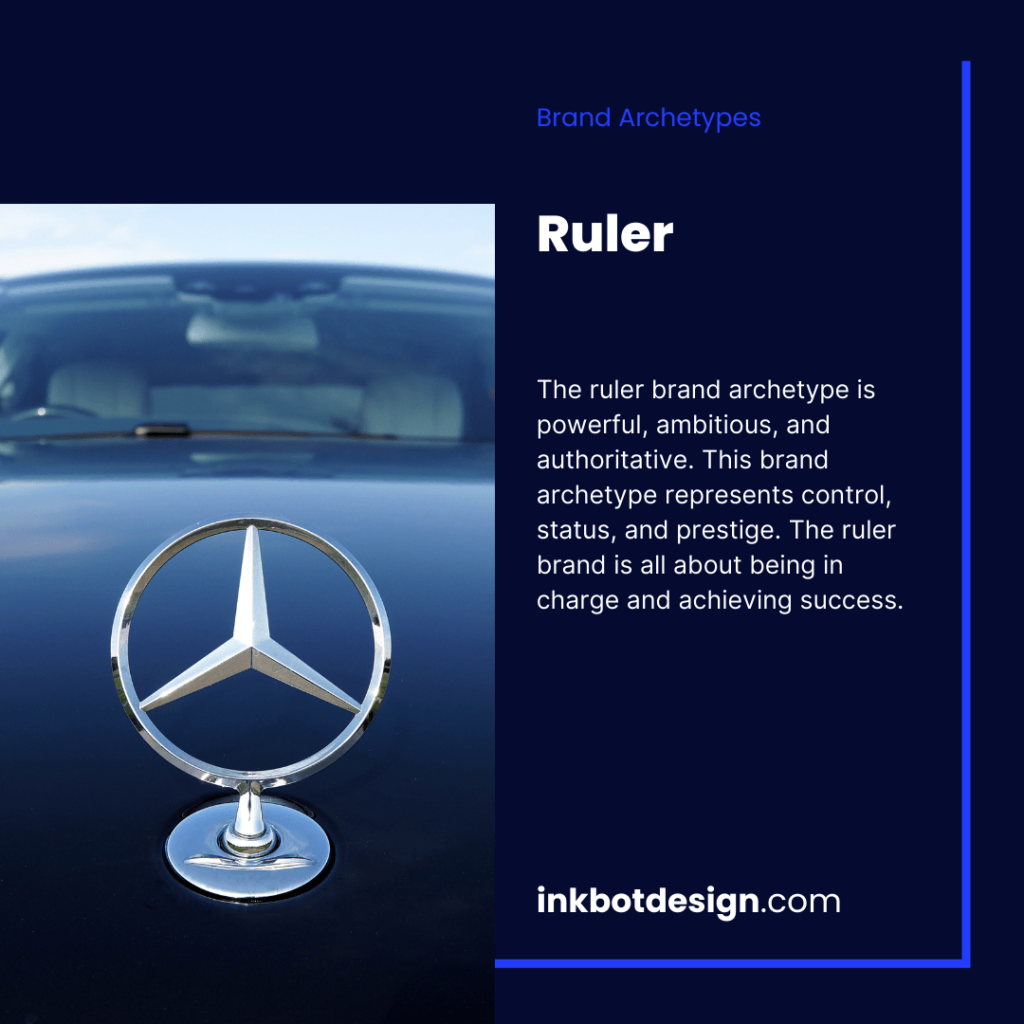
“The Ruler” archetype epitomises leadership, authority, and control. Brands that embrace this archetype position themselves as dominant figures in their respective industries, commanding respect and instilling trust in their target audience.
Characteristics of “The Ruler” Archetype:
“The Ruler” archetype encompasses several defining characteristics. Here are some key traits associated with this commanding branding persona:
- Authority and Leadership: Brands embodying “The Ruler” archetype assert their authority, often seen as industry leaders and trendsetters. They command respect and inspire trust through their expertise and strong vision.
- Control and Order: These brands thrive on power and exhibit meticulous planning and execution. They create a sense of order and stability in the market, reassuring customers that they can rely on their products or services.
- Confidence and Poise: “The Ruler” exudes confidence and self-assurance. Such brands are bold, unwavering in their actions, and convey a strong belief in their capabilities.
- Prestige and Luxury: Brands aligned with “The Ruler” archetype often embody luxury, prestige, and exclusivity. They offer premium products or services that elevate the customer experience, positioning themselves as the ultimate choice for discerning consumers.
- Responsibility and Accountability: The Ruler takes responsibility for their actions and is accountable for their brand's impact on society. They often commit to ethical practices, corporate social responsibility, and sustainable initiatives.

Real-World Examples:
Now, let's explore some real-world examples of brands that have successfully embraced the “The Ruler” archetype:
- Rolex: As a renowned luxury watchmaker, Rolex personifies “The Ruler” archetype. With its rich history, precision craftsmanship, and iconic designs, Rolex has established itself as the authoritative figure in the watch industry, symbolising prestige, wealth, and success.
- Mercedes-Benz: This iconic automotive brand embodies the qualities of “The Ruler.” With a long-standing reputation for engineering excellence, luxury, and performance, Mercedes-Benz dominates the automotive market and commands respect as a leader in the industry.
- IBM: International Business Machines (IBM) exemplifies the “The Ruler” archetype through its dominance of global technology and consulting services. IBM is known for its visionary leadership, cutting-edge innovations, and ability to shape the digital landscape, positioning itself as a trusted authority in the field.
- American Express: With its prestigious charge cards and premium services, American Express portrays the essence of “The Ruler” archetype. It caters to an exclusive clientele, offering superior customer service, extensive benefits, and an aura of financial control and sophistication.
“The Ruler” archetype holds immense power and appeal in the branding landscape. Brands that successfully embody this archetype command authority instil trust, and exhibit control over their respective industries. Through leadership, confidence, and prestige, brands like Rolex, Mercedes-Benz, IBM, and American Express exemplify the commanding qualities of “The Ruler.” By aligning their brand identities with this archetype, they have carved out a unique space in the market, captivating consumers who seek excellence, exclusivity, and an unwavering sense of control.
11 – The Magician Archetype: Unveiling the Enchantment

The Magician archetype is a master of transformation and possesses the ability to make dreams a reality. This archetype uses its visionary power to create enchanting experiences for its audience, leaving them spellbound and craving more. The Magician archetype understands the power of imagination and harnesses it to inspire, motivate, and encourage individuals to believe in the extraordinary.
Brands that embody the Magician archetype are often associated with innovation, cutting-edge technology, and transformative experiences. These brands possess an otherworldly aura, elevating themselves above the mundane and presenting their products or services as magical.
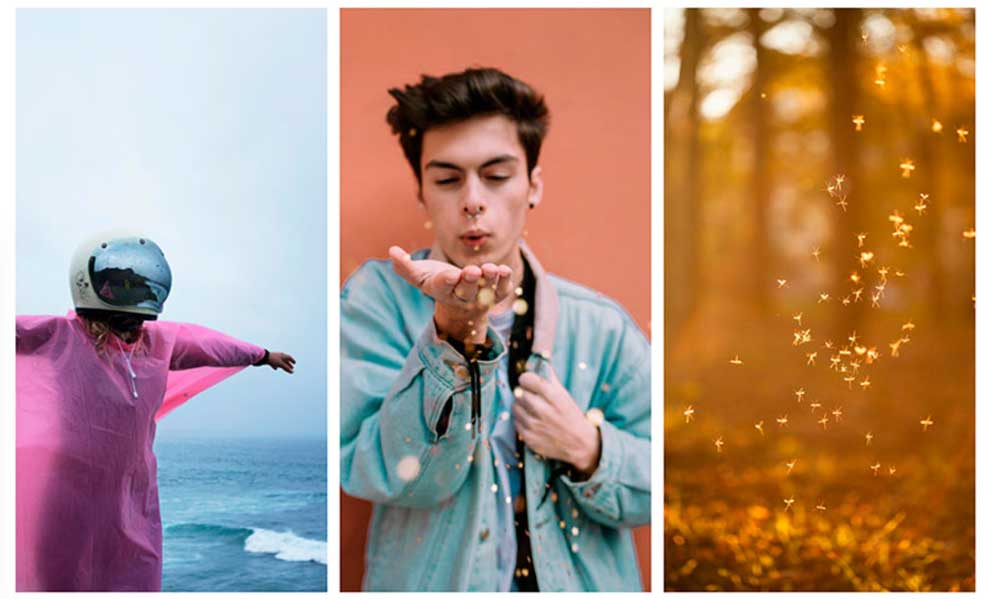
Examples of the Magician Archetype in the Real World:
- Apple: Apple is a brand that exemplifies the Magician archetype. With its visionary leader, Steve Jobs, at the helm, Apple consistently introduced groundbreaking products that revolutionised the tech industry. Apple's ability to combine sleek design, intuitive interfaces, and user-friendly experiences created a sense of wonder and awe among its customers. The brand's captivating product launches and ability to transform how we interact with technology make Apple a quintessential Magician archetype.
- Tesla: Tesla, led by the enigmatic Elon Musk, is another brand that embodies the Magician archetype. Tesla has disrupted the automotive industry with its electric vehicles and sustainable energy solutions. Tesla's ability to transform the perception of electric cars from mundane and environmentally friendly to luxurious and high-performance has mesmerised the world. By pushing the boundaries of what is possible, Tesla has created an aura of innovation and magic around its brand.
- Disney: Disney, the mastermind behind timeless stories and enchanting experiences, is an archetype of the Magician. From animated classics to theme parks, Disney creates magical worlds where dreams come true. Disney's ability to transport audiences into realms of fantasy and imagination is unparalleled. By weaving tales of heroes, princesses, and talking animals, Disney captures the hearts of both young and old, creating an enduring connection with its audience.
- Airbnb: the online platform connecting travellers with unique accommodations demonstrates the Magician archetype. By transforming the way people experience travel and hospitality, Airbnb has disrupted traditional hotel industries. The brand enables individuals to step into the shoes of locals and live in extraordinary spaces, offering a sense of wonder and adventure. Airbnb's ability to create magical moments and unforgettable experiences makes it a perfect example of the Magician archetype.
The Magician archetype in branding holds the power to create awe-inspiring experiences, pushing the boundaries of what is possible. Brands that embody this archetype captivate their audience by tapping into the realm of imagination and innovation. Through transformative products, visionary leadership, and a touch of magic, these brands create a sense of wonder and inspire individuals to believe in the extraordinary.
12 – The Outlaw Archetype: Unleashing the Rebel Spirit
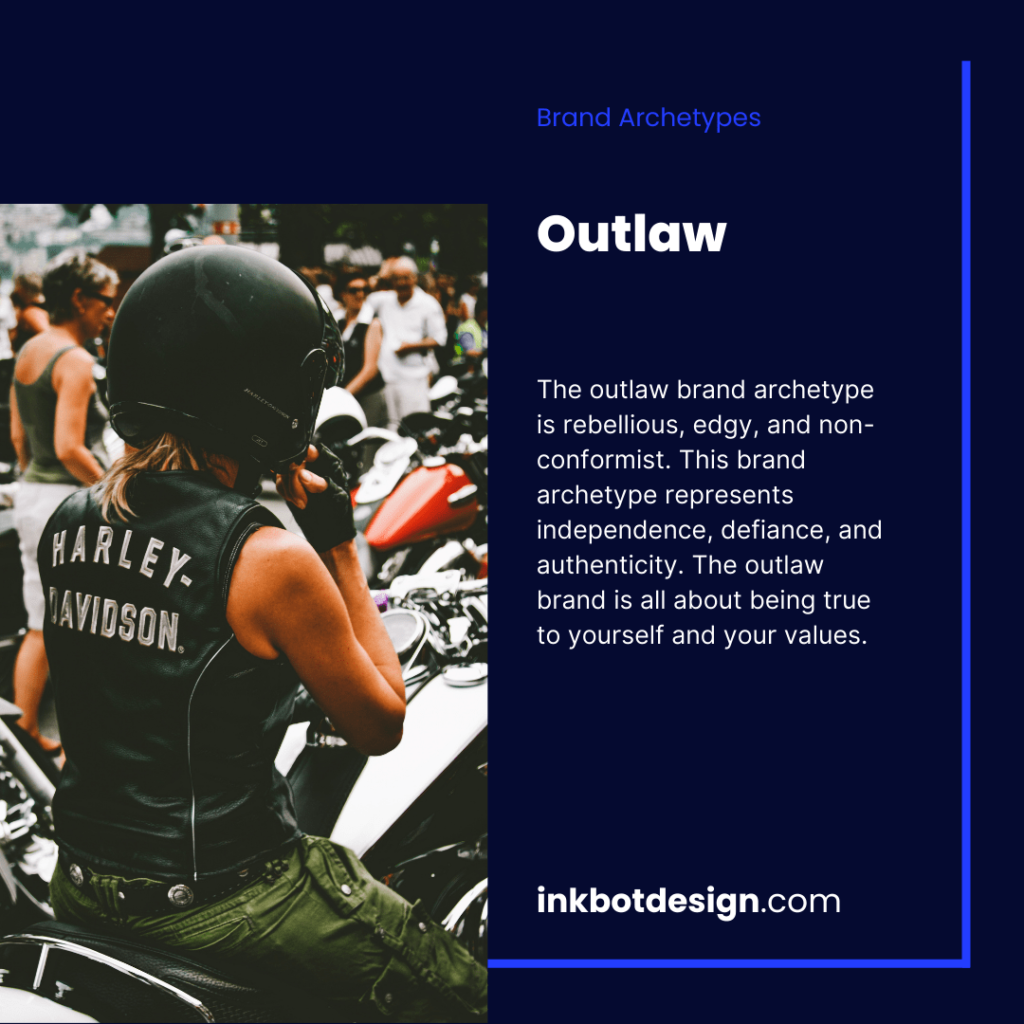
The Outlaw archetype embodies rebellion, nonconformity, and a relentless pursuit of freedom. It thrives on breaking the rules, challenging authority, and disrupting established systems. Brands that adopt the Outlaw archetype aim to liberate their customers from societal constraints, inspire change, and empower individuals to embrace their unique identities. They celebrate authenticity, self-expression, and an unwavering belief in pushing boundaries.
Key Characteristics:
- Nonconformity: The Outlaw archetype revels in being different. It embraces individuality, rejects societal norms, and encourages consumers to defy expectations.
- Disruption: Brands following the Outlaw archetype disrupt the status quo, challenging outdated conventions and encouraging innovation and change.
- Authenticity: The Outlaw archetype values honesty and transparency. It fosters genuine connections with its audience by presenting an honest, unfiltered image.
- Freedom: These brands celebrate freedom of thought, expression, and action. They empower individuals to carve their paths and live on their terms.
- Passion: The Outlaw archetype is fueled by a fiery passion for its cause, unafraid to take risks and fight for what it believes in.
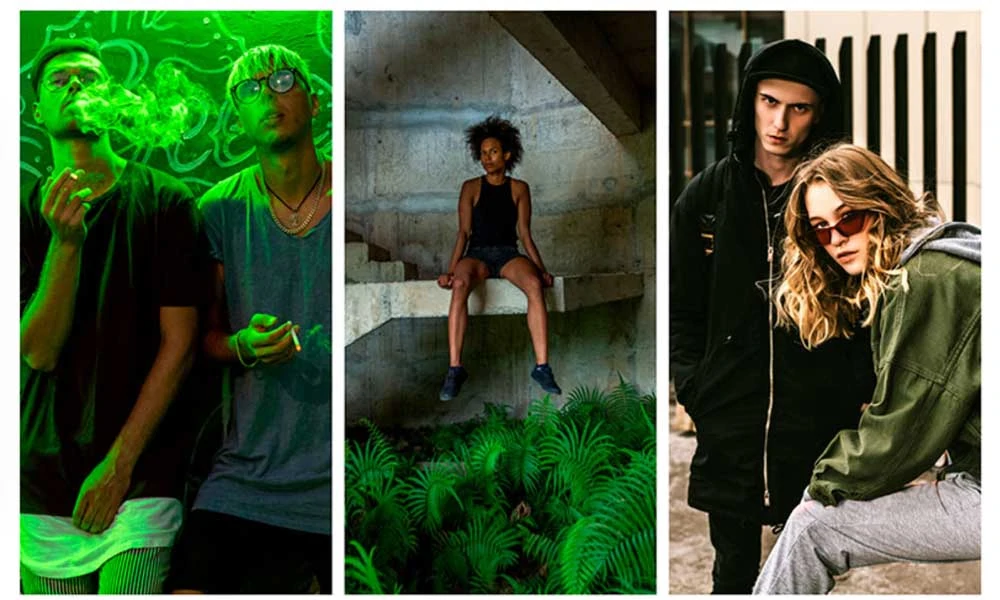
Real-World Examples:
- Harley-Davidson: Harley-Davidson, the iconic motorcycle brand, embodies the Outlaw archetype. Harley-Davidson defies societal norms and represents freedom, individuality, and the open road with its rebellious spirit, leather-clad image, and roaring engines. It empowers its customers to embrace their adventurous side and break free from conformity.
- Patagonia: the outdoor apparel company Patagonia demonstrates the Outlaw archetype through its unyielding commitment to environmental activism. It defies the traditional profit-driven model by placing sustainability and ethical practices at the forefront. Patagonia encourages consumers to rebel against fast fashion and embrace a more conscious lifestyle.
- Ben & Jerry's: Ben & Jerry's, the renowned ice cream brand, leverages the Outlaw archetype by championing social justice causes. It fearlessly speaks out on climate change, racial inequality, and LGBTQ+ rights. Through its flavours and advocacy campaigns, Ben & Jerry's inspires consumers to take action and challenge the existing social order.
- Red Bull: the energy drink giant Red Bull embodies the Outlaw archetype through its daring and extreme marketing campaigns. It associates itself with adrenaline-pumping sports and events, defying conventions and encouraging individuals to push their limits. Red Bull inspires a rebellious and adventurous spirit, fueling its customers to embrace their wild side.
The Outlaw archetype in branding represents the rebel spirit that resides within all of us. It embraces nonconformity, celebrates authenticity, and inspires individuals to challenge the status quo. Brands like Harley-Davidson, Patagonia, Ben & Jerry's, and Red Bull have successfully adopted the Outlaw archetype to forge deep connections with their customers and create a lasting impact. So, if you're looking to build a brand that dares to be different, challenges norms, and inspires change, the Outlaw archetype might be the key to unlocking your brand's untamed potential.
Implementing Branding Archetypes
Identifying Your Brand's Archetype
To effectively implement branding archetypes, businesses must identify the archetype that best aligns with their brand's values, personality, and target audience. This process involves:
- Brand Analysis: Analysing the brand's mission, deals, and unique selling proposition to understand its essence.
- Consumer Research: Conducting market research and surveys to gain insights into consumers' desires, preferences, and aspirations.
- Archetype Selection: Match the brand's characteristics and consumer insights with the most appropriate archetype(s) to create a cohesive brand identity.
Consistency and Coherence
Consistency is vital when leveraging branding archetypes. Once an archetype has been chosen, it should be infused into every aspect of the brand, including:
- Visual Identity: Design elements such as logos, colours, and typography should reflect the chosen archetype.
- Brand Voice: The tone and language used in brand communication should align with the archetype, creating a coherent and authentic brand voice.
- Messaging and Storytelling: Crafting brand messages and narratives that resonate with the chosen archetype, reinforcing the brand's identity.
Evolving with the Archetype
As brands evolve, it is essential to ensure that the chosen archetype remains relevant and adaptable. This involves:
- Audience Analysis: Continuously monitoring and understanding the target audience's changing needs, aspirations, and values.
- Archetype Evaluation: Regularly assessing the alignment between the brand and the chosen archetype, making adjustments if necessary.
- Innovation: Embracing innovation and staying attuned to emerging trends to maintain the brand's relevance and resonance.
Conclusion
Branding archetypes offer a robust framework for companies to build strong and lasting connections with their target audience. By tapping into universal human characteristics and values, businesses can create compelling brand identities that evoke emotions, inspire action, and foster brand loyalty. Whether it's the Hero, Sage, Rebel, or Caregiver, each archetype offers unique attributes that can be leveraged to differentiate a brand and leave a lasting impression on consumers. So, embrace the power of branding archetypes and unleash your brand's full potential in the hearts and minds of your customers.
Last update on 2024-05-11 / Affiliate links / Images from Amazon Product Advertising API

